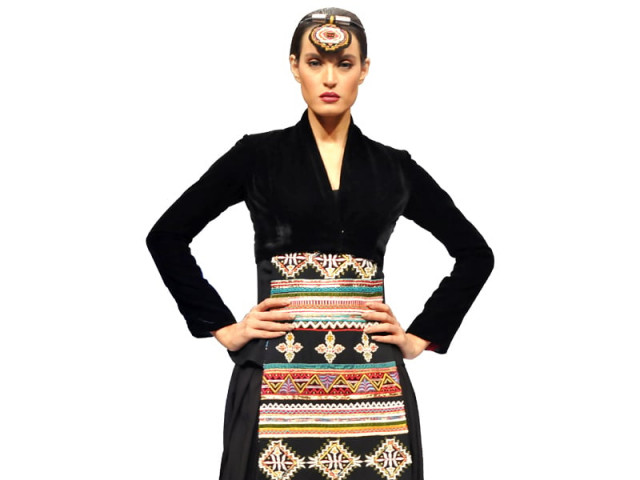The long and short of it
Pakistani women seem determined to go to any lengths to keep the ankle-skimming tunic in fashion.

The long and short of it
I often perform an odd and potentially embarrassing experiment on certain women. At the most elegant of soirees, I will approach a glamorous socialite and ask her why she continues to follow the trend of wearing long tunics even when the garment obviously drowns her diminutive frame and makes her look even shorter than she is. More often than not, the reply from these women is that they wear it because it’s “in fashion”. This, of course, exasperates me since, to be truly stylish as opposed to trendy, it is necessary to don clothes according to one’s body type, complexion and age.
Fashion experts say that in the swinging 60s Pakistani women were truly fashion forward, wearing short, sleeveless shirts with churidaar pants and accessorising their daring outfits with beehive hairdos and Jackie O-inspired sunglasses. Pakistani women have now turned into a nation of clones, all wearing similar lawn prints and those pesky long tunics.
Are Pakistani designers simply following women’s demands in churning out the same safe and boring designs rather than introducing revolutionary silhouettes? And will these voluminous floor-skimming tunics ever go away?
“We are desperate to get rid of them,” says Safinaz Muneer, one half of the uber-successful designer duo Sana Safinaz. “Our latest collection for the export market is all about shorter lengths. But for the past 18 months, I have actually been nauseated by the long tunics!”
“The truth is the market is not yet receptive to short lengths,” adds Sana Hashwani. “People are not ready to let go because it is an easy cover-up.”
Camouflage your worst
While designers might be slowly pushing shorter lengths to clients, another reason for their endless stay is that they manage to camouflage and hide the typical subcontinental woman’s hereditary pear shape and her bumps and bulges. “People are not ready to let go because it is an easy cover-up,” says Hashwani.
In the west, the wrap dress made popular by Diane Von Furstenberg does the same for Caucasian women. “These long, loose, formless tunics allow women to feel free and unself-conscious when they are lolling about amongst themselves at kitty parties,” explains Yasmeen, a stylish design entrepreneur who supplies embroidery for British designers such as Sir Paul Smith and Osman Yousefzada. “If they wore more structured, leaner silhouettes — which I personally believe help to improve your carriage and posture, making it more elegant — they would feel more conscious about any bulges and sags.”
A time and place for everything
To this I would add my belief that working women, especially those employed in male dominated offices, prefer the long lengths, to keep the look work-appropriate since formfitting attire simply does not have a place in the office.
At the same time, argues Sana, “One needs to educate women that you can’t wear a ball gown to work. I might encourage women to wear a short and slim tunic to work but I wouldn’t wear it to a wedding where I would opt for a long flowing tunic.”
Sana adds that for evening wear and for weddings a demand for the long and flowing ‘princess look’ will remain as there is no way of attaining that ideal with a short length.
A season of change
“If you peruse lawn catalogues,” says Sana, “you’ll see that we have been introducing short lengths for the past two years. We constantly have to be one step ahead which is why we have always done short versions of every design.
But now I think the trend is changing because women are suddenly wearing shorter lengths. Although most designers are still doing longer lengths, by next year we hope to see the trend change drastically.”
The verdict
Personally, I feel that Pakistani women have a ‘Princess Fascination’ and the long, airy, flowing gown-like tunics transmute women into princess mode. On the other hand, designers happily provide this voluminous cover-up, perhaps because they can justify charging the customer more since the garment uses up more fabric. The worst sartorial combination, in my opinion, is when these long floor-skimming tunics are worn with oversized Kimono or Raglan sleeves. Add to it some thick, lace borders at the hem and paired with Dhaka or Memoni shalwars and what you have is a boxy, monastic monstrosity.
Dont’s
Do not blindly follow fashion trends that do not suit your body shape or lifestyle
Look for clothes that flatter your figure and minimise your flaws and highlight your body’s strengths. Long tunics do none of that.
Do’s
Do choose a bright colour
A brighter colour will help you exude confidence and warm up your complexion.
Do add a bold accessory
If you feel more comfortable in a conservative black or winter white top, infuse some drama with a great statement necklace, a long strand of colourful beads or cocktail ring.
Do select tunics with youthful accents
A keyhole neckline, delicate beading, grommets, crochet and brocade designs will make your tunic look youthful. A few well-placed embellishments will keep the style from looking frumpy or boring
Do wear flowing shirts over churidaar pajamas or skinny jeans
This minimises figure flaws yet accentuates the positives such as shapely legs and a full bust. The lack of definition around the hips and waist draws attention away from that area.
Do pair a long, flowy top with great heels
The shirt and the shoes should complement each other, as they will be the visual points of interest on both the top and the bottom.
Tips
If you are 5’0” or thereabouts avoid wearing tunics which swamp you. Opt for tailored at-the-knee shirts and pair them with slim pants and high heels. When dressing for the office, wear longer shirts with low slits that are comfortable and made from breathable fabrics such as pure cotton, rather than flowing embroidered silk and chiffon gown-like tunics.
If you wear long voluminous ‘Princess Look’ tunic to a wedding, pair it with churidaars rather than the wide palazzo or Dhaka pajamas.
Ease into the shorter lengths by wearing trailing shirts which hit thigh high from the front and trail to below the knee from behind.
Published in The Express Tribune, Ms T, July 1st, 2012.


















COMMENTS
Comments are moderated and generally will be posted if they are on-topic and not abusive.
For more information, please see our Comments FAQ